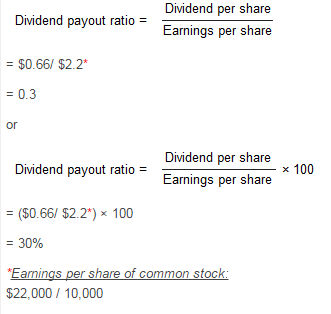Dividend payout ratio discloses what area of the current earnings the corporation is paying to be able to its stockholders such as dividend and what portion the corporation is ploughing back in the commercial for growth in future. It is calculated by dividing the particular dividend per share because of the earnings per share (EPS) for the specific time.
Formula
The formula of dividend payout ratio is given below

The numerator from the above formula would be the dividend per reveal paid to typical stockholders only. It doesn’t include any dividend settled to preferred stockholders.
It is also computed by dividing how much of dividend settled on common stock within a particular period with the total earnings there for common stockholders to the period.

Dividend payout ratio is also expressed in percentage. When expressed in percentage, the formula is written as follows:

or if total dividend and total income figures are used:

Example
Suppose a Company has declared and paid a dividend of $0.66 per share of common stock. The company does not have any preferred stock outstanding. The information about common stock and net income is given below:
Common stock (10,000 shares, $25 par value)… … … $ 250,000
Net income … ….. ….. …… ……. ……… …….. …….. …… ..$ 22,000
An investor seeking for continuous dividend income wants to purchase the share of the Company. For this purpose he requests you to compute the dividend payout ratio for him from the above information.
Solution













